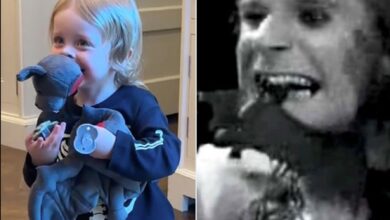Brian Hyland’s ‘Itsy Bitsy Teenie Weenie Yellow Polka Dot Bikini’ Delivers a Burst of Lighthearted Pop to the Charts in 1960
During the warm months of 1960, a whimsical tune titled Itsy Bitsy Teenie Weenie Yellow Polka Dot Bikini swept across airwaves and took the music world by surprise. It signaled the arrival of a youthful voice, Brian Hyland, and embodied the easygoing, fun-loving spirit of a generation on the verge of major cultural shifts. The song’s infectious rhythm and cheeky storytelling resonated deeply with the youth, quickly propelling it to the top of the Billboard Hot 100 and igniting a wave of bubblegum pop enthusiasm.
At just 16 years old, Brian Hyland became a national sensation thanks to this breakthrough hit. Hailing from Queens, New York, Hyland had already been singing in local doo-wop groups, showcasing a natural gift for melody and charm. Once he signed a solo contract, everything changed. His clean-cut image and fresh vocals made him the perfect icon for a generation of teens hungry for something bright and new. Although he later evolved artistically, this early success defined the start of his musical legacy.
The quirky concept for the song came from songwriters Paul Vance and Lee Pockriss, who specialized in light-hearted pop numbers. Inspired by a personal anecdote involving Vance’s young daughter feeling self-conscious in her new swimsuit, they built an entire narrative around that moment. The lyrics painted a humorous picture of a bashful girl refusing to leave a changing booth due to her polka-dot bikini, cleverly mirroring the era’s budding openness in fashion and social norms. Beneath the playful tone, the song reflected broader societal shifts in modesty and youth expression.
The track was recorded at Bell Sound Studios in New York City, where Pockriss oversaw the production. Musically, it was bright and brassy, filled with punchy horns and toe-tapping percussion. Hyland’s youthful delivery perfectly matched the song’s light tone, while the background vocals, including the memorable spoken countdown, gave the piece its quirky personality. The production was clean and punchy, a reflection of the meticulous care put into crafting what would become a timeless pop anthem.
When the song hit the market, it skyrocketed. Within just a few weeks of its debut on the Billboard Hot 100 in July 1960, it soared to the No. 1 position. The charm of the lyrics, combined with Hyland’s breezy delivery, made it an irresistible radio staple. It wasn’t just an American phenomenon—listeners overseas embraced it as well. In the UK, for instance, it cracked the Top 10. Beach parties, summer gatherings, and radio stations made the tune part of their seasonal identity for years to come.
The bikini, though introduced years earlier, was still controversial in the conservative climate of the 1950s. The song, with its amusing story about a girl’s embarrassment, helped nudge public opinion toward acceptance. As the 1960s dawned, society was beginning to embrace bolder fashion choices, and this track served as a lighthearted, cultural icebreaker. In many ways, it helped usher in a more relaxed view of swimwear and body image, all while hiding behind a melody that could make anyone smile.
Although the song gave Hyland his big break, it also typecast him early on. Many critics and listeners saw him as a novelty act, making it hard for him to be taken seriously as an artist. Nevertheless, he worked hard to evolve, eventually achieving success with more emotional material. Tracks like Sealed with a Kiss and Gypsy Woman allowed Hyland to show depth beyond bubblegum pop, but the polka-dot bikini tune would forever remain his calling card.
Its success marked more than just a milestone for Hyland—it helped shape the emerging genre of bubblegum pop. Characterized by its cheerful sound, youthful themes, and radio-ready structure, this genre found a foothold in the following decade. Groups like The Monkees and The Archies would go on to embody that same carefree style, borrowing liberally from the bright tones and simple structures popularized by Hyland’s breakout single. The song’s legacy extended to compilation albums and nostalgic summer playlists for decades to come.
Other artists recognized the track’s enduring appeal. In 1990, Bombalurina revived the song for a new audience, topping the UK charts and bringing a fresh, slightly cheeky energy to the classic. Many more covers followed, from remixes designed for dance floors to versions sung in other languages. The core story, playful and universally understood, made it a candidate for reinterpretation in nearly every genre imaginable. The song’s adaptability became a major factor in its ongoing popularity.
By the time the song was circulating through radios worldwide, the 1960s were preparing to usher in a series of cultural upheavals—from civil rights movements to musical revolutions. In that context, Itsy Bitsy Teenie Weenie Yellow Polka Dot Bikini may have seemed like pure fluff, but its success reflected a growing appetite for youth-centric, less formal expressions of identity. It offered a harmless laugh and a catchy chorus during a time of significant transition, making it a unique historical artifact in pop culture.
Even now, the song continues to appear in movies, ad campaigns, and retro-themed TV shows. Whenever a scene needs a beach vibe or a reference to carefree innocence, this tune often finds its way into the mix. Its legacy is undeniable, preserved in the memories of those who heard it first and embraced anew by younger generations discovering it in new contexts.
Though often labeled a novelty song, Itsy Bitsy Teenie Weenie Yellow Polka Dot Bikini holds a significant place in music history. It encapsulates a moment when pop was playful, unpretentious, and joyfully infectious. While Brian Hyland proved he was more than a one-hit wonder, this song remains his most iconic contribution, representing an entire generation’s light-hearted soundtrack.
Ultimately, the song reminds us that music’s power lies not only in its depth or complexity, but also in its ability to make us smile. With a simple story, an unforgettable melody, and an irresistible energy, Itsy Bitsy Teenie Weenie Yellow Polka Dot Bikini continues to enchant audiences across decades. Its legacy is as enduring as it is unexpected—proof that a cheerful summer hit can live on far longer than anyone might have guessed.





